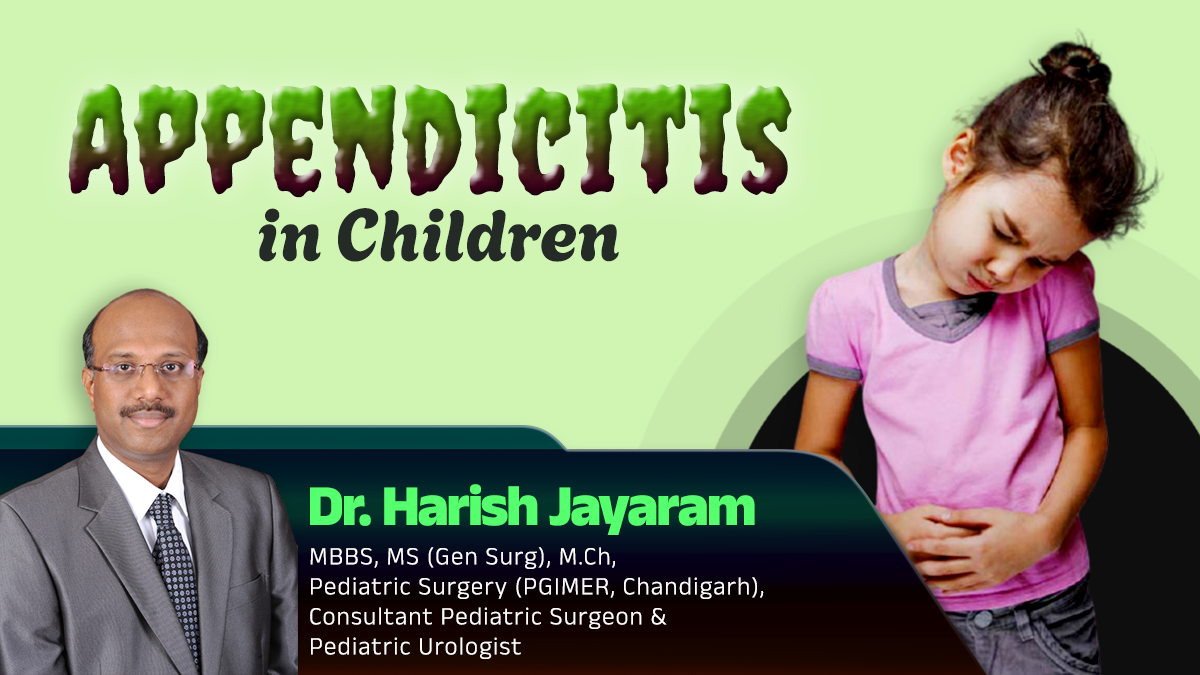News & Articles
Appendicitis in Children

When Mr Prasad who was 37 years was diagnosed to have appendicitis and underwent an emergency appendicectomy, his family and colleagues in office were only concerned about when he would come back to work. A few months later, his son who was 6 years old was also diagnosed to have appendicitis. That was when everyone was shocked. “Appendicitis in a child? Never heard of such a thing. Must be a wrong diagnosis. Should take a second opinion” they said.
What is Appendicitis?
The Appendix is a worm like structure attached to the first portion of the large intestine called cecum and found in the right lower part of the abdomen. Initially thought to be a useless structure, it is now found to aid the immune system. It harbors bacteria. Appendicitis occurs when mucus, stool, or a combination of the two blocks the opening of the appendix that leads to the cecum. Bacteria proliferate in the trapped space and infect the lining of the appendix. If the inflammation and blockage are severe enough, the tissue of the appendix can die and even rupture or burst, leading to a medical emergency.
Why do children get appendicitis?
Studies have reported that the appendicitis incidence to vary according to dietary habits, hygiene, socioeconomic status, ethnicity, seasonal changes, positive family history, age and gender. Low fiber intake and the resulting constipation are thought to be the cause of childhood appendicitis in 70% of the cases.
Has the incidence of appendicitis in children increasing in recent times?
Some advances which are obviously good for any society like better hygienic conditions and better socioeconomic status are paradoxically related to increasing incidence of appendicitis. India is in this league of countries where appendicitis in children is unfortunately increasing. In a study published from Canada in 2017, the incidence of appendicitis is increasing rapidly in the developing countries. Even more concerning data emerged from University Hospitals; Leicester, UK in the same year where researchers concluded that the incidence of appendicitis was significantly increasing in children less than 14 years.
How do we diagnose appendicitis in a child?
The common complaint or symptom of appendicitis is a sudden appearance of abdominal pain in the right lower abdomen often associated with vomiting and fever. The surgeon elicits several clinical signs to diagnose appendicitis, the most common being the ‘MC Burney’s point rebound tenderness’. However these symptoms and signs described may not always be present in a child making the diagnosis more difficult and resulting in delays in diagnosis. The progress of the disease is more rapid in children resulting in the rupture (perforation) of the appendix causing progressive pus formation.
Many a times, other conditions in children mimic appendicitis like pneumonia, severe intestinal infection or rarely an ovarian condition in a girl child. It is important to accurately establish the diagnosis before any surgical intervention. A good history and a detailed examination of the child clinches the diagnosis most of the time, but sometimes need confirmation by imaging in the form of an ultrasound scan or rarely CT scan.
How does the Pediatric Surgeon treat appendicitis in children?
Once the diagnosis of appendicitis is confirmed, emergency surgery to remove the appendix is undertaken. Conventional open surgery has now given way to laparoscopic or key-hole surgery even in small children and in advanced stages of the disease with good results in experienced hands. However a small percentage of children with very early or uncomplicated appendicitis can be treated with antibiotics under the watchful eye of the surgeon for sudden complications like rupture of the appendix. Even if the child improves without surgery, there is always a chance of appendicitis coming again sometime in the future.
Can there be problems after successful surgery?
There can be disease related or procedure related long term issues. If the appendix was found ruptured with lot of pus in the abdomen, there is a small chance of bowel loops getting stuck in these areas and cause blockages requiring re operations. If the operation is done laparoscopically, then the procedure related complications like wound infection, hernia in the wound and intestinal blockages are very minimum.
Facts about childhood Appendicitis
- Childhood appendicitis is on the raise and increasingly seen in younger and younger children.
- Rarely newborn babies too have been reported to have appendicitis
- A general trend towards a diet with less fiber could be the cause of increasing incidence of appendicitis in children.
- The symptoms of appendicitis may not be as classical as seen in adults and may delay the diagnosis.
- Appendicitis in children more commonly progresses rapidly to advanced stages like rupture.
- Appendicitis is treatable by laparoscopy just like in adults in any stage.









